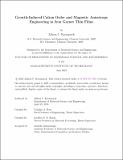Growth-Induced Cation Order and Magnetic Anisotropy Engineering in Iron Garnet Thin Films
Author(s)
Kaczmarek, Allison C.
DownloadThesis PDF (105.1Mb)
Advisor
Ross, Caroline A.
Beach, Geoffrey S. D.
Terms of use
Metadata
Show full item recordAbstract
At its heart, Materials Science and Engineering is a discipline seeking to advance technologies by improving the materials that make them. Currently, the development of electronic devices is limited by the need for materials that enhance speed, reduce size, and improve energy efficiency. Spin-based memory devices, which encode data in a material’s magnetic state, offer a promising solution. Magnetic memory technologies are widespread today, powering devices such as memory disks, tapes, and magnetic random access memory (MRAM). While garnet materials have long been studied for these applications, they have faced challenges in becoming adoptable technologies. However, with advanced research techniques and a deeper understanding of material behaviors, magnetic garnets are experiencing a renaissance. This thesis explores the engineering of iron garnet thin films for next-generation spin-based memory applications. The work presented advances the understanding of non-equilibrium growth, characterization, and engineering of iron garnet thin films and their magnetic properties, emphasizing kinetic phenomena that govern atomic organization beyond classic ordering of unit cells and emergent magnetic anisotropy. In a composition series of europium-thulium iron garnet (EuTmIG) films, experiment confirms the 50-year-old theory of cation site preference of Eu and Tm, demonstrating that enhanced magnetic anisotropy, named ’magnetotaxial anisotropy’, is linked to cation ordering during growth. These findings lay the foundation for anisotropy engineering by cation order. Further studies investigate the effects of film formulation, growth kinetics, and post-growth annealing on structural ordering and magnetotaxial anisotropy. In bismuth-yttrium iron garnet (BiYIG) films, a linear relationship between Bi-Y ordering, magnetic anisotropy, and substrate-lattice mismatch provides deeper insight into the forces that drive cation ordering. Annealing is shown to further enhance magnetic anisotropy in these films. In lutetium-yttrium iron garnet (LuYIG) films, the laser pulse rate during growth by pulsed laser deposition is shown to influence Lu-Y ordering and magnetic anisotropy, reinforcing the kinetic nature of the cation ordering. The findings of this thesis contribute to the fundamental understanding of cation ordering in complex oxide films and provide a framework for engineering and characterizing garnet materials, enabling the future development of new spintronic devices.
Date issued
2025-05Department
Massachusetts Institute of Technology. Department of Materials Science and EngineeringPublisher
Massachusetts Institute of Technology